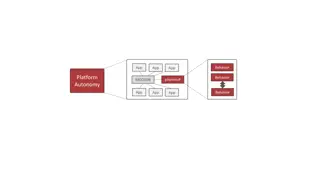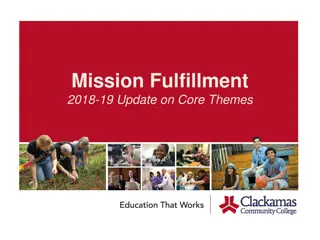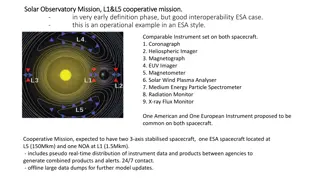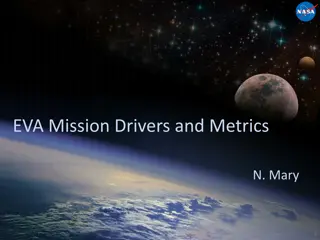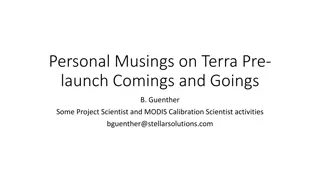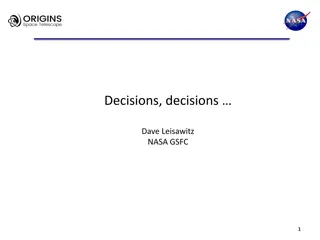
Lunar Reconnaissance Orbiter Mission Support
Explore the Lunar Reconnaissance Orbiter's mission support for landing sites on the Moon from September 2022 to September 2025. Discover how the LRO provides critical data for site selection, characterization, and future surface missions, leveraging its unique capabilities to enhance lunar exploration.
Download Presentation

Please find below an Image/Link to download the presentation.
The content on the website is provided AS IS for your information and personal use only. It may not be sold, licensed, or shared on other websites without obtaining consent from the author. If you encounter any issues during the download, it is possible that the publisher has removed the file from their server.
You are allowed to download the files provided on this website for personal or commercial use, subject to the condition that they are used lawfully. All files are the property of their respective owners.
The content on the website is provided AS IS for your information and personal use only. It may not be sold, licensed, or shared on other websites without obtaining consent from the author.
E N D
Presentation Transcript
ESM5: Mission Support
Some Notes: Time period of extended mission: September 2022 to September 2025 ESSIO is advocating that LRO support of landing sites be included as an evaluation criteria. In prior proposals we have had guidance for science value, no real metric for mission support beyond Relevance/ benefit to other NASA missions/priorities (maximum of two pages) Page count available in the proposal: 6 pages?? Due Date: January 14
Things We need to keep in mind to emphasize: LRO is the only US asset at the Moon capable of supporting commercial lunar landers and other future surface missions. LRO payload was designed for landing site assessment LRO is currently supporting landing site characterization requested (via NASA HQ) from CLPS and other space agencies. We have experts in all relevant data sets from LRO and previous missions, including expertise in landing site assessment. The types of images and data products desired to plan and execute a landed mission on the Moon are not available for the entire lunar surface. New observations will be essential. Site selection and characterization will require both existing and newly acquired data Opportunities enabled by landed/other missions: What can we do in conjunction with CLPS/Artemis, not only watching a mission land, but simultaneous measurements from orbit. How can we leverage these landings?
Observations pre Observations pre- -landing: 1) site analysis and selection 1) site analysis and selection 2) operations planning 2) operations planning 3) science support 3) science support landing: From ESM4: new Diviner and CRaTER observations to enhance temporal coverage, enabling improved temperature, thermal inertia, H-parameter, and radiation mapping LRO team to create specialized data products from existing and newly acquired data from all seven instruments, such as regional maps of temperature, rock abundance and size distribution, surface roughness, slopes, craters, and volatiles. Acquisition of data to create landing-site specific predictive models of lighting, thermal, radiation, and earth visibility for specific sites and dates that teams can examine to optimize their mission operations timelines.
Observations pre Observations pre- -landing continued: landing continued: Science Support: science/exploration collaboration Science Support: science/exploration collaboration ESM5 LRO science investigations focused on regions known to be already targeted for upcoming landers; opportunities for ground truth; synergistic or complimentary investigations Known landing locations for missions just before and during ESM5: Lacus Mortis (2021, Q4) Oceanus Procellarum (2022, Q1 or Q2) Mare Crisium (2023, Q2) Reiner Gamma (lunar swirl) (2023, Q4) Schr dinger Basin (impact melt) (2024, Q4) Gruithuisen Domes (nearside silicic volcanic construct. Expected to have roving capabilities) (2025, Q2) South Pole locations: Generally within 6 degrees of the south pole (2022 (Q4); 2023; 2024 (Q4))
Observations pre Observations pre- -landing continued: landing continued: ESM5 science investigations to support future exploration high priority targets: Mapping out regions that could be used to test big picture hypotheses Real world examples (i.e. investigating SPA: rovers, robotic sample return, humans). Showcase what LRO can do for an investigation area (IA) Mechanisms for lunar science and exploration communities to propose target areas? Observations of key target areas (investigation areas) to support surface activities could include: Stereo Featured mosaics obliques Traverse paths between key investigation areas
Observations during surface operations: Observations during surface operations: As possible, attempt to directly observe a landing? (a complex endeavor!) Image assets on the surface Observations to provide context for surface science investigations: temperature, lighting, and radiation conditions Coordinated observations at the surface and in orbit Ranging to surface assests? Monitor effects of exploration activities on the lunar environment. ESM4 Examples: LAMP: remotely observe the exhaust of a landing or the plume of an impact [Gladstone et al., 2010; Stern et al., 2013; Hurley et al., 2014] measure the migration of water and evolution of vapor through the exosphere deposition of exhaust from a descent burn
Observations after surface operations: Observations after surface operations: Collaborative science observations post-surface operations? Opportunities for ground truth. Effects of surface operations on the lunar environment over time? ESM4 Examples: Characterize changes to the regolith as a result of the landing plume [Kayadash et al., 2011; Clegg et al., 2014; Clegg-Watkins et al., 2016] The relationship between lander dry mass and blast zone area can be used for predicting the likely extents of disturbance resulting from rocket exhaust for future lunar soft landings.
CLPS: Observations providing operations and scientific support before, during, and after surface operations Coincident observations during CLPS surface operations 1) 2) CLPS missions planned for time period of ESM5: TO 19C: Q4 of 2022: South Pole: imaging, Sample acquisition system, Near-IR volatile spectrometer, mass spec, neutron spectrometer system, linear energy transfer spectrometer, infrared imaging system, rover (Moon Ranger) PRIME-1: Q4 of 2022: South Pole: Drill (Pime-1), mass spectrometer TO 19D: Q2 of 2023: Mare Crisium: 10 payloads: regolith characterization, Heliospheric X-ray Imager, Reconfigurable, Radiation Tolerant Computer System, Lunar Magnetotelluric Sounder, subsurface thermal characterization, stereo cameras, Electrodynamic Dust Shield, Lunar GNSS Receiver Experiment (LuGRE) TO 20A: late 2023: Viper rover, mass spectrometer PRISM 1a: Q4 2023: Reiner Gamma, TBD PRISM 1b: Q3 of 2024: Schr dinger Basin, TBD PRISM ??: Q4 of 2024: South Pole, TBD PRISM ??: Q2 of 2025: Gruithuisen Domes, TBD
Artemis: 1) Coverage of the northern most extent of the Artemis zone 2) What new observations can we include of key target areas to support surface activities including traverses between key investigation areas (i.e. stereo, featured images, and obliques). Timing: - NASA is still aiming for the first crewed landings in late 2024 or 2025, near or at the end of ESM5. - Landing location is still planned for within ~6 degrees of the south pole
International Mission Support During ESM5, there is a mixture of technology demonstrations, landers, rovers, and sample return missions planned by the international community. Some examples of surface missions currently planned: Japan: 2022 lunar lander technology demonstration UAE: 2022 lunar lander and rover demonstration China: Chang e 6 (2024): Sample-return from the lunar south pole; Chang e 7 (2024): South pole lander, rover and flying probe Russia: 2025 Lander, part of Luna-Glob programme UK: 2025 lunar sample return
Mission Support and Exploration Science Questions: Example from ESM4 Radiation effects during an increase in solar activity










